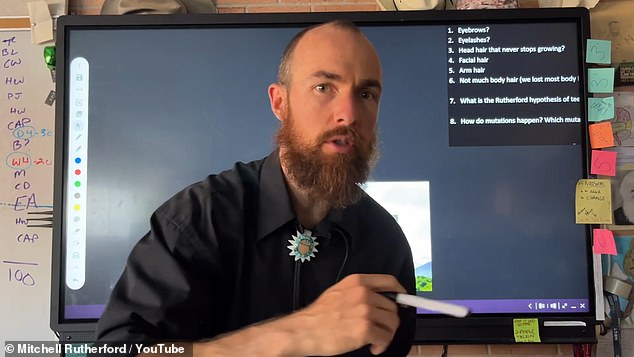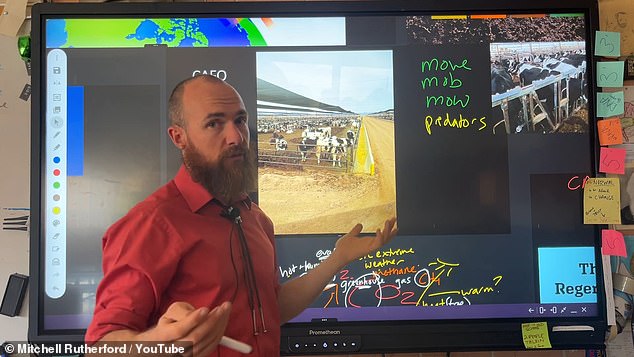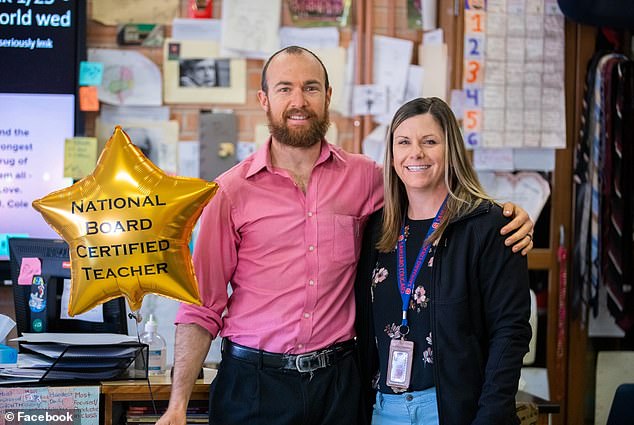Teachers are so exhausted from spending hours trying to get kids to put down their phones that they abandon them in droves.
Mitchell Rutherford, a biology teacher at Sahuaro High School in Tucson, Arizona, finally gave up after 11 years, feeling burned out and frustrated.
He tried everything: a “phone jail” basket that few students used, teaching lessons on social media addiction and meditation, and taking children on nature walks.
But none of that worked. Students were unmotivated and openly said they didn’t care about their grades, and half failed their classes.
Mitchell Rutherford, a biology teacher at Sahuaro High School (pictured with a colleague) in Tucson, Arizona, finally gave up after 11 years, feeling burned out and frustrated.
Instead of learning, they put their headphones on in class and tuned out, saying it helped them with their “anxiety.”
“I was using all the tools in my belt and more than half the class didn’t seem to be trying at all,” Rutherford told the Wall Street Journal.
The problems began when the school reopened after the pandemic and have only gotten worse since then, with this year being the final straw.
Rutherford, 35, initially said it was behavioral problems as students relearned how to socialize among their peers at school.
“Distracted students are always the least happy, whether in the moment or later,” he wrote on Twitter in 2022 alongside one of the many hand-drawn motivational posters he posts in his classroom.
‘But concentrating takes practice and work! Focusing on anything strengthens the muscle and noticing distractions helps too!’

Rutherford said that instead of learning, students put on headphones in class and tuned out, saying it helped with their “anxiety.”
This year the students seemed to behave better, but it soon became clear that the problems were still there, just below the surface.
“There was a low-energy apathy and isolation,” he told the WSJ, recalling how it made him depressed and anxious until he realized phones were the problem.
Phones in class, where school policy says they shouldn’t be out, were always something teachers had to monitor, but kids generally accepted it.
“Now you can ask them, pester them, plead with them, remind them and try to punish them and still nothing works,” Rutherford said.
Rutherford compared constant phone use to an addiction and tried to help them understand that the apps they were hooked on were designed to keep them scrolling.
He remembered how the children would tightly grab his phone when he asked them to hand it over in class.
“That’s what an alcoholic would do if they tried to take the bottle away,” he told them.

Rutherford compared constant phone use to an addiction and tried to help them understand that the apps they were hooked on were designed to keep them scrolling.
Rutherford and her fellow Sahuaro teachers compared notes on the strategies they used and ultimately found some that worked.
But he said they were exhausting since the moment he relaxed in his application, students immediately “recoiled” toward the fatal scroll.
By February, he had had enough and told the school that this year would be his last, but he tried one more thing on the way out and it finally seemed to work.
He challenged his students on a “digital detox” in which they tracked their phone use and tried to reduce it and spend more time in the real world.
They would then write a paper about the experience and receive lab credit.
The results surprised him, as students who didn’t care about their grades managed to drastically change their screen use.

Rutherford will leave Sahuaro (pictured) after the school year to teach at an online college preparatory school or vocational program for high school students.
Isabel Richey, one of his AP biology students, said she used to scroll through TikTok for six hours a day and never study for more than 10 minutes without opening it.
“I used my phone at the beginning of every class and never turned it off,” he said.
The detox challenge reduced it to one hour a day. She has read nine novels and feels less stressed and generally in a better mood.
The success made him regret having left, as if he were abandoning his students, but he felt consumed and exhausted and could not continue living like this.
Instead, she hoped to teach in an online college prep school or vocational program for high school students, both of whom would have children who were more motivated and able to put away their phones.


